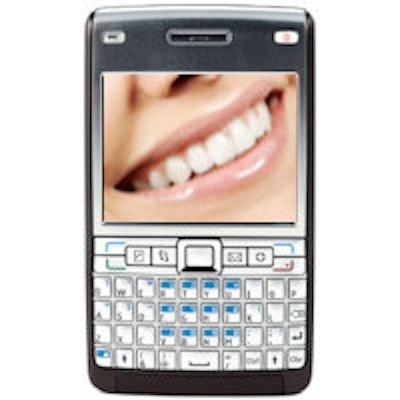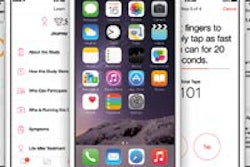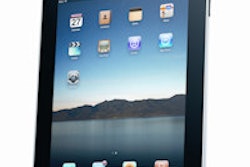
Mobile phones are ubiquitous in most societies, and they are gradually being supplanted by smartphones. For example, the Pew Internet and American Life project has found that as of May 2013, 91% of Americans own a mobile phone while 56% own a smartphone.
Now, a new report published in the Journal of Orthodontics has taken a look at which apps are most useful for orthodontic specialists or offer patients sound guidance (September 2013, Vol. 40:3, pp. 249-255). The study could help clinicians find apps for their own use and facilitate meaningful conversations with their patients about how apps can augment their treatment.
"It is inevitable that patients will access resources on the Internet in order to gain information on orthodontics, either before starting treatment or during treatment," Parmjit Singh, BDS, a locum consultant for the orthodontic department at Chelsea and Westminster Hospital in London wrote in an email to DrBicuspid.com. "Given that people are increasingly using smartphones where they would traditionally have used print, patients should be told about Internet resources available."
“The information they offered was relevant and appropriate.”
For his study, Dr. Singh searched for apps that are available for smartphones on the Android, Apple iOS, Blackberry, and Windows operating systems. His goal was to provide an overview of the orthodontic apps that are currently available while zeroing in on apps for new and existing orthodontic patients and clinicians.
He used four keywords -- braces, orthodontist, orthodontic, and orthodontics -- to find the apps to be included in the study, and used the summary or description that accompanied each app in the search results to determine their appropriateness for the study.
"Only apps directly relating to the field of orthodontics were finally analyzed," Dr. Singh wrote in his study.
The keyword searches turned up a large number of apps that were irrelevant to anyone searching for something related to orthodontics, Dr. Singh noted. Consequently, practitioners interested in sharing recommendations for useful apps with their patients could consider the ones he investigated to save their patients time and effort.
No orthodontic apps were available for Blackberry or Windows, which is likely a reflection of the significantly larger market share that Apple and Android enjoy over their competitors. The Pew report noted that 28% of U.S. cellphone owners have an Android, 25% have an iPhone, and 4% have a Blackberry.
Dr. Singh categorized the apps by those for clinicians and those for patients. Next, he grouped apps for marketing orthodontic practices and those that simulated the appearance of orthodontic appliances on self-capture photos taken by the user (simulators) separately from the rest. "Virtually every app had some benefit," Dr. Singh told DrBicuspid.com.
Clinician apps
"Of the 11 apps considered to be designed specifically for orthodontic clinicians, three related to orthodontic meetings, while a further three were used to access publications," Dr. Singh wrote. The International Journal of Orthodontics had its own app called Intl Assoc for Orthodontics, for example.
Three apps provided information about orthodontic products. Carriere Ortho 3D has animations of its Carriere Distaliser and patient education tools for Carriere products. The application also "shows the correction of various malocclusions and contains a library of the self-ligating bracket system and a range of different arches and auxiliary components," Dr. Singh explained.
Another app called WiredOrtho, produced by an orthodontic laboratory and braces manufacturer, had patient literature, videos, and information about the courses offered by the company. And "FAQFix is an app that guides you in the positioning of orthodontic brackets by using the FA Q-Fix positioners," Dr. Singh wrote. "It offers step-by-step instructions on tuning, inserting, and removing the positioners."
His search turned up two tooth width calculators. Practitioners can enter tooth width dimensions into the BoltonCalc app to find out if there is a tooth-size discrepancy, while the "iModelAnalysis performs several model analyses such as Bolton, Howes, and Tanaka-Johnston," Dr. Singh noted.
All of these apps, except for Bolton Calc, were free.
For patients
The study turned up four patient reminder apps. "These aligner change apps were simply sophisticated alarm clocks," Dr. Singh explained. "However, the very fact that it is an app in its own right and provides patients with target wear times, makes the patient take more of an interest in their treatment and may improve overall compliance."
Two of them, Braces Accelerator and Rubberband Reminder for orthodontic braces, sent alerts to the app's user and could produce compliance graphs that could be used by the clinician. The orthodontist-developed Align On Time has practice marketing material and enables the patient and clinician to set aligner change schedules, informing the patient when it is time to use the next aligner in their treatment.
Meanwhile, Smile Mission also had a reminder function. Both Smile Mission and MyBraces apps had a feature that enabled patients to upload photos to monitor the progress of their treatment over time.
"Only one orthodontic manufacturer was found to have an app targeting patients about their appliance system (3M Incognito)," Singh noted. This app had information about proper care for the appliance, where to find providers, and a feature for tracking the change in tooth positions with photos.
Lastly, there were two troubleshooting apps for patients with braces. iBracesHelp had advice for a range of specific problems, while StraightenMe utilized a decision tree that led to a slide show video explanation of how to manage their orthodontic issue.
"The info apps would be useful if a patient encountered an 'orthodontic emergency' and wanted to know how to fix or reduce their problem until they could see their orthodontist," Dr. Singh said. "The information they offered was relevant and appropriate."
Dr. Singh noted that there are concerns about orthodontic apps that may be addressed in the future.
"A logical step would be that the apps available should be validated so that patients can be directed to appropriate apps," he told DrBicuspid.com. The U.S. Food and Drug Administration (FDA) has issued guidance for developers of mobile medical applications, for example, and this could be expanded upon.
One solution he proposed could reassure the user about the content of an app if it comes from a trusted source. "Professional groups may, in time, consider producing apps of their own," he explained. "The British Orthodontic Society already has an extensive website with an entire section for patients. Hopefully, we will see this information extended into an app format."



















